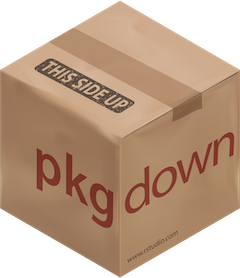
You can alter the design/styling of your pkgdown website to suit your brand and needs. There are two main techniques:
Theming changes colours, fonts, spacing etc. using a Bootswatch template, Bootstrap variables, Bootstrap rules, or custom CSS.
Layout changes the content (or ordering) of e.g. the navbar, authors page, or
<head>tag, by using pkgdown options or templates.
This vignette begins with a discussion of the most common theming and layout options made available through _pkgdown.yml. We’ll then discuss how to customise the underlying HTML template files, this is less commonly needed but gives you full control over the appearance of the website. Next, we’ll discuss how to give multiple sites the same style by using a package, and we’ll finish up with some workflow advice.
Getting started
Most theming features work only with Bootstrap 4, so begin by updating your site to use Bootstrap 4 by adding the following lines to your _pkgdown.yml:
template:
bootstrap: 4Overall, the site should look pretty similar, but you should notice a number of small improvements; most importantly the default font is much bigger, making it considerably easier to read. Upgrading to Bootstrap 4 has a low chance of breaking your site, but if you were managing your own pkgdown templates or using custom CSS, you might need to tweak a few files.
Theming
There are three main ways to change the visual style of your site:
With a pre-packaged bootswatch theme.
By customising theme variables via bslib.
With your own CSS and JS.
They can be combined depending on your needs.
Choosing a Bootswatch theme
The easiest way to change the appearance of your website, or to start changing it, is to pick a complete Bootswatch theme. You can choose any Bootswatch theme that’s compatible with the Bootstrap version you use. Run either bslib::bootswatch_themes(3) or bslib::bootswatch_themes(4) to get a list. If you were using the paper theme, note that it was renamed materia in Bootstrap version 4.
To choose a Bootswatch theme here’s what to write in your pkgdown configuration.
template:
bootstrap: 4
bootswatch: materiaNB: Some Bootswatch templates like lux or pulse won’t work out of the box because of their tall navbar. You’ll need to use custom CSS to add padding to the body.
By default pkgdown uses an accessible colour scheme for code highlighting designed to work well on a light background. If you wish to opt out of this colour scheme to suit a dark Bootswatch theme better, set highlightcss to false:
template:
params:
highlightcss: falseYou will then have to provide your own CSS rules for syntax highlighting.
bslib variables
Rather than picking an entire theme, you can customise individual theme components using bslib variables:
template:
bootstrap: 4
bslib:
font_scale: 1.2
base_font:
google: "Prompt"
heading_font:
google: "Muli"
code_font:
google: "JetBrains Mono"
bg: "#202123"
fg: "#B8BCC2"
primary: "#EA80FC"
success: "#4F9B29"
info: "#28B3ED"
warning: "#FD7424"
danger: "#F7367E"The main bslib variables you can use to create a theme are bg, fg, and navbar-bg. Optionally, you can also include primary and secondary. Below is a list of which pkgdown website elements each variable will change:
You may also add more specific variables if you wish to override any of these global theme variables:
You can find a full list of variables in vignette("bs4-variables", package = "bslib").
You can also combine both approaches, starting with a Bootswatch theme then changing the bits you don’t like:
template:
bootstrap: 4
bootswatch: materia
bslib:
bg: "#202123"
fg: "#B8BCC2"More CSS / JS / other assets
If you know CSS or JS, you can customise your site by including pkgdown/extra.css or pkgdown/extra.js. These will be automatically copied the home directory of your website and inserted into the <head> (after the pkgdown defaults).
You can add arbitrary additional files by putting them in pkgdown/assets/BS4. The contents will be automatically copied to the root of your website folder by pkgdown by init_site().
Layout
You can also customise the contents of the navbar, footer, and sidebar that appears on the home page of your site. Furthermore, if you want to tweak which authors of the package appear in the sidebar and footer, also refer to ?build_home.
Templates
Other layout changes require tinkering with pkgdown templates (in inst/templates in pkgdown source). Three pkgdown templates are empty by default, so you can fill them with your own content:
-
in-header.htmlis inserted right before closing the head tag. -
before-body.htmlis inserted right after opening the body tag. -
after-body.htmlis inserted right before closing the body tag.
To add content to these templates:
- Create a folder
pkgdown/templates. - Create
in-header.html,before-body.htmlorafter-body.htmlin that folder, depending on your needs. E.g. you could save the lines corresponding to your analytics provider, if not Google Analytics, inpkgdown/templates/in-header.html. - Edit and save that file.
- Re-build your website, inspect it (and its source, if needed).
It is possible to customise other templates but this is recommended for advanced users only because you’ll need to keep it up to date as pkgdown itself changes. If you’ve used head.html in the past, we now recommend switching to using in-header.html instead. A limitation to tweaking templates is that your templates can only access data that pkgdown specifically supplies; you can learn more in the documentation and source code of render_page().
Conclusion
In this vignette we explained how to change the theming and layout of pkgdown websites. Further work to improve user experience is:
- Working on the article (
?build_articles) and reference indexes (?build_reference). - Writing a compelling README that explains why your package is so cool/useful/fun.
- Improving the contents of the individual articles and reference topics 😉.